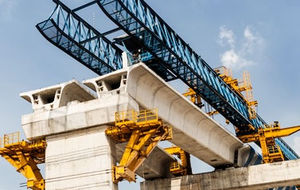New Delhi (IANS) The government’s strategy of stepping up investments in big ticket infrastructure projects in the road, rail and ports sectors has driven up the country’s GDP growth rate and played a key role in enabling India to emerge as a bright spot amid a worldwide economic slowdown.
A massive Rs 10 lakh crore allocation for infrastructure in the budget this year by the Narendra Modi government reflects the importance of the sector with the speed of highway construction touching a phenomenal 37km per day, a rapid expansion taking place in the Indian Railways network through line doubling and electrification of tracks and a surge in the expansion of seaports and airports.
The Budget 2023-24 cites ‘infrastructure and investment’ as one of the seven top priorities guiding the country.
Addressing a post-budget webinar on Infrastructure and Investment, PM Modi said that infrastructure development is the driving force of the country’s economy, which is the path for achieving the target of becoming a developed nation by 2047. “Now we have to improve our speed and move in top gear.”
The national highway network in the country has expanded by over 60 per cent from about 91,287 km in March, 2014 to about 1,46,145 km at present. This comes on the back of a massive boost in capital expenditure on the sector from Rs 51,000 crore in 2013-14 to more than Rs 2,40,000 crore in 2022-23, putting the country on the course to being five trillion dollar economy, Highways Minister Nitin Gadkari said in Parliament this week.
The Road Transport and Highways Ministry has laid focus on development of high-speed access controlled corridors and 4-lane road networks in order to improve logistics efficiency in the country.
The length of the four-lane plus national highway network, including High Speed Corridors, has increased from about 18,371 km in March, 2014 to around 46,179 km so far this year. Project implementation has already been started on 21 green field access-controlled corridors including expressways in which work in about 3,336 km length has been completed, the minister told Parliament in a written reply.
The ministry has also identified 35 Multimodal Logistics Parks for development to improve logistics efficiency to the Indian economy. These are aimed to expedite movement with an integrated road-rail-port corridor for the transport of cargo.
The country’s railway budget also increased to impressive Rs 2.40 lakh crore from a mere Rs 29,000 crore in 2013-14. The Modi government has pursued the electrification of the railway network at a record speed. Railway Minister Ashwini Vaishnaw recently informed the Lok Sabha that as of June 30, 2023, a total of 59,096 route kilometres on the Broad Gauge network has been electrified.
Out of this, the lion’s share of 37,011 route kilometres has been electrified during the last nine years. The figures imply that close to 95 per cent of the entire railway network has been electrified.
In another major achievement, work on the 1337 km Eastern Dedicated Freight Corridor has been completed this year at a cost of Rs 1.09 lakh crore and 70 per cent of the work on the 1507 km Western Dedicated Freight Corridor has also been finished. These corridors will reduce the logistics cost and lead to the development of new industrial hubs and Gati Shakti Cargo Terminals.
The government has also rolled out over 30 state-of-the-art Vande Bharat trains to cut travel time and another 400 are to be manufactured in the next three years. Metro rail projects have been taken up as well in 30 cities to improve the urban transport system
Prime Minister Narendra Modi has announced the PM Gati Shakti National Master Plan, with the aim of accelerating development activities in the country, institutionalising holistic planning and inter-departmental coordination through a single integrated portal which has expedited the implementation of infrastructure projects.
The Sagarmala Project, which has focused on crucial aspects such as port connectivity, coastal development and shipping infrastructure has also moved at a fast pace over the last eight years. A total of 802 projects have been initiated across the country with an investment of Rs 5.6 lakh crore which aim to transform the maritime landscape.
India’s logistics costs have now come down to 8.9 per cent of gross domestic product (GDP), as better infrastructure created by higher government expenditure on highways, ports and digitisation has speeded up the movement of cargo, according to a report released on Friday.
The report “Logistics Cost in India,” authored by National Council of Applied Economic Research (NCAER), said logistics costs including transportation, warehousing, insurance and administrative charges had come down thanks to improvements in road network, tax reforms and digitisation of supply chains.
Logistics costs are now comparable to many Western economies, and the government is aiming to further improve infrastructure through higher state and private investments, said Rajesh Kumar Singh, Secretary, Department for Promotion of Industry and Internal Trade (DPIIT).
India has climbed six places to rank 38th out of 139 countries in the World Bank’s Logistics Performance Index for 2023, due to its improving road and port networks and digitisation of supply chains.
Airport infrastructure has also been taking rapid strides in the country. Civil Aviation Minister Jyotiraditya Scindia said at a conference on ‘overall development in the infrastructure in India’ recently “while only 74 airports were built until 2014 since Independence, as many as 75 airports and helipads were constructed in the last 10 years, taking the number to 149, and by 2030, this will go past 200.”

